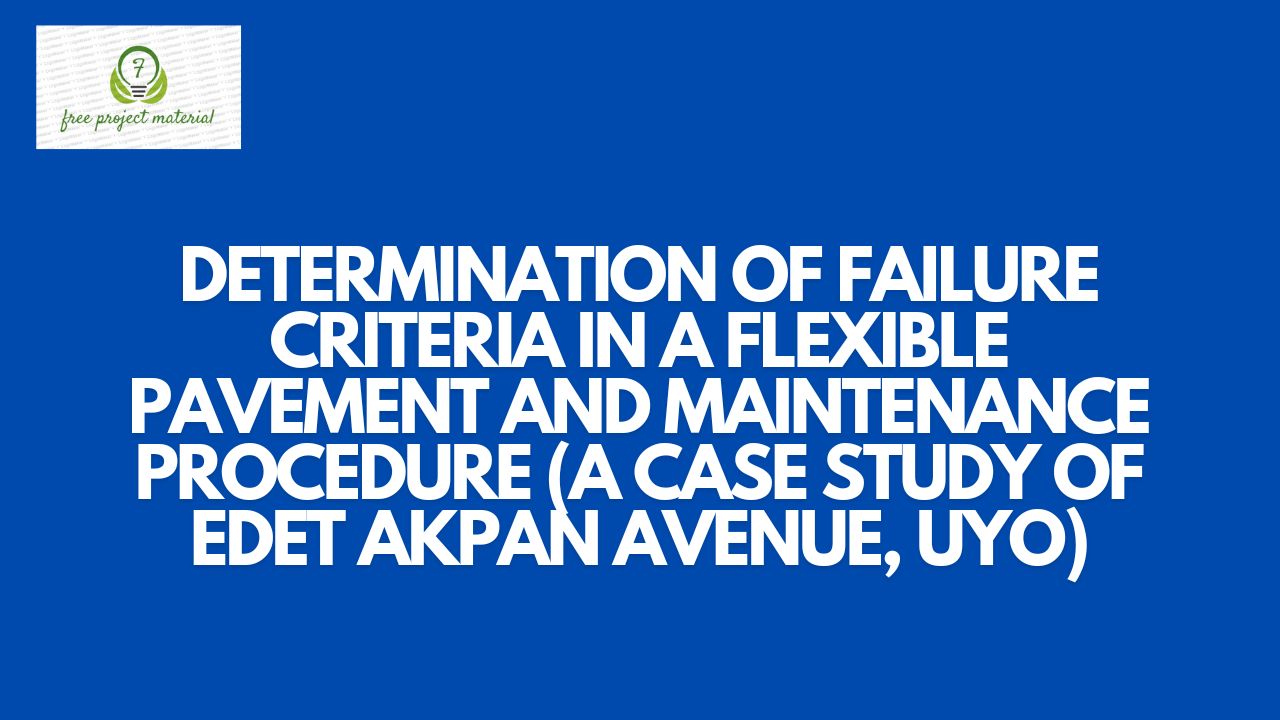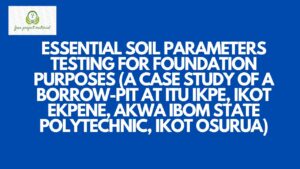ABSTRACT
The objective of this research work was to establish failure criteria in flexible pavement and recommend suitable maintenance procedure. The literature review revealed the extent of work done by other scholars on this research topic, but none was related to the study location in Akwa Ibom State. The research method is a forensic study which reviewed the visual road condition, field and laboratory test results of the study road materials. This research revealed that the failure on study road was as a result of number of reasons. First, the plastic index of the base course material was about 16% which exceeded the recommended 10%. The asphalt extraction test revealed that the bitumen content was 4.6 against the 6% to 6.5% that is recommended. It was recommended that the subgrade soil should be proof rolled, the sub-base and base material should be stabilized or replaced. From the pavement conditions rating, hot mix asphalt overlay was recommended for the overall pavement.
TABLE OF CONTENTS
Title Page – – – – – – – – – i
Certification – – – – – – – – – ii
Dedication – – – – – – – – – iii
Acknowledgements – – – – – – – iv
Abstract – – – – – – – – – v
Table of Contents – – – – – – – – vi
CHAPTER ONE: INTRODUCTION
1.1 Background of the Study – – – – – – 1
1.2 Statement of Problem – – – – – – 4
1.3 Aim and Objectives of the Study – – – – 5
1.4 Significance of the Study – – – – – – 5
1.5 Scope and Limitation of the Study – – – – 6
1.5 Definition of Terms – – – – – – 6
CHAPER TWO
LITERATURE REVIEW
2.1 Road Deterioration – – – – – – – 8
2.2 Types of Pavement – – – – – – – 9
2.3 Layers of Flexible Pavement – – – – – 11
2.4 Flexible Pavement Distress – – – – – – 16
2.4.1 Alligator/Fatigue Cracking – – – – – 18
2.4.2 Bleeding – – – – – – – – 20
2.4.3 Block Cracking – – – – – – – 21
2.4.4 Corrugation and Shoving – – – – – 23
2.4.5 Depression – – – – – – – – 24
2.4.6 Joint Reflection Cracking – – – – – 24
2.4.7 Longitudinal Cracking – – – – – – 25
2.4.8 Rutting – – – – – – – – – 27
2.4.9 Potholes – – – – – – – – 28
2.5 Maintenance of Flexible Pavement – – – – 29
CHAPTER THREE
METHODOLOGY
3.1 Research Method – – – – – – 35
3.1.1 Inspection and Evaluation Plan – – – – 35
3.1.2 Pavement Condition Survey – – – – – 36
3.1.3 Experimental Work – – – – – – 36
3.1.4 Identification of the Possible Cause(S) of Failure – – 37
3.1.5 Selection of the Best Maintenance Option – – – 37
3.1.6 Report on Outcomes – – – – – – 38
CHAPTER FOUR
ANALYSIS AND DISCUSSION OF RESULTS
4.0 Case Study – – – – – – – – 39
4.1 Inspection and Evaluation Plan – – – – 40
4.2 Field Survey of Distresses – – – – – 40
4.3 Experimental Work – – – – – – 46
4.4 Identification of the Possible Cause(S) of Failure – – 49
4.4.1 Gradation Analysis and Plasticity Index results – – 49
4.4.3 Field Density Results – – – – – – 50
4.4.4 Asphalt Marshall and Extraction Test – – – – 51
4.5 Pavement Condition Rating – – – – – 53
4.6 Maintenance Option – – – – – – 55
CHAPTER FIVE
SUMMARY, CONCLUSION AND RECOMMENDATION
5.0 Summary – – – – – – – – 56
5.1 Conclusions – – – – – – – 56
5.2 Recommendations – – – – – – – 57
References
CHAPTER ONE
INTRODUCTION
1.1 Background of the Study
The construction sector plays an important role in the development not only of the sector itself but also of other economic sectors. Construction activity generally contributes much to the country’s total activity, at least with the corresponding demand for materials and labor inputs. The swings in the level of construction activity tend to both magnify and lead the movements in the economy. As stated by the Ethiopian Roads Authority (2005), construction is widely acknowledged as the most important single constituent in a developing country‘s investment program with about 50% of total capital formation which is realized through the construction industry of the road sector. The construction industry has a major influence on the economic growth of a country and is, conversely, dependent on the state of the economy for the realization of its potential (ERA, 2015).
The deterioration of a country’s transport facilities is a clear indication of the decline of economic growth. Road deterioration has neither narrowed in developing countries in general and in Nigeria in particular nor is a new concern for the World Bank which published the Road Maintenance Problem and International Assistance in 2016 to draw attention to the matter. What is new, however, is the scale to which road deterioration has progressed in so many developing countries. Neglected or delayed maintenance causes expensive re-constructions and rehabilitation requirements, affecting all sectors of the economy. Effective and efficient road maintenance is required to reduce the rate of deterioration which would prolong the life of the facility, lowers vehicle operating costs of the users by providing a good running surface (WB Maintenance, 2017).
Road transport is the moving engine for other sectors and activities in developing countries. It provide access to industry, agriculture, investment, health services and education through providing of goods and passengers. And the lack of good roads or the existence of poorly maintained road are barriers to the development and investment in developing countries.
A highway pavement is a structure consisting of layers of natural and processed materials above the natural ground (often called subgrade or roadbed). A pavement’s primary function is to distribute the vehicle loads from the top of the pavement to a larger area of the subgrade without causing any damage to the subgrade.
Pavement failure occurs when an asphalt surface no longer holds its original shape and develops material stress which causes issues. Pavement failure issues include cracking, potholes, depressions, rusting, shoving, upheavals, and raveling (Okikbo, 2012).
Flexible pavement fails due to any one of the following three failures. They are sub-grade failure, sub-base or base course failure and wearing course failure. The pavement deterioration usually is not only the result of poor design and construction but also it is caused by the inevitable wear and tear that occurs over years, variation in climate, increasing multi axle’s vehicles and heavy traffic (Hnin and Tin, 2014).
The effectiveness of a preventive maintenance treatment is directly related to the condition of the pavement. Conducting preventive maintenance activities on a sound pavement in good condition will be very effective in prolonging that pavement’s service life. Conducting an inappropriate repair (either method or timing) can actually accelerate the rate of distress development. Preventive maintenance is generally planned and cyclical in nature. Its intent is to repair early pavement deterioration, delay pavement failures and reduce the need for corrective maintenance and service activities. Although this type of maintenance is not performed to improve the load carrying capacity of a pavement, it extends the pavement useful life and level of service. Often, preventive maintenance methods are designed to repair damage caused by the environment. Periodic renewal of the pavement surface can provide several benefits, including sealing the pavement surface, which prevents water from penetrating into the pavement structure and controlling the effects of oxidation, raveling and surface cracking. Environmental conditions remain fairly consistent over time, so the maximum time between preventive maintenance treatments should be based on time, rather than the amount of traffic on a roadway section (Asma and Suda, 2011).
Critical elements of a successful pavement preservation program are:
- Selecting the roadway
- Determining the cause of the problem
- Identifying and applying the correct treatment (s)
- Determining the correct time to do the needed work
- Observing performance
1.2 Statement of Problem
Asphalt pavement road deterioration extended much faster than the corresponding maintenance budgets and institutional capacities. Traffic has also become much heavier than expected, and axle loadings have often exceeded the designed capacity of pavements.
1.3 Aim and Objectives of Study
The aim of this study is to determine the failure criteria in flexible pavement and to ascertain the maintenance procedure
The specific objectives of this study are;
- Identify the major factors that cause flexible pavement Failure.
- Assess the road maintenance practice
- To determine the best criteria for assessing flexible pavement failure
- Recommend intervention measures to minimize the frequent failure factors for flexible pavement.
1.4 Significance of the Study
This research is to provide immediate benefits to road users by identifying the causes of frequent failures of flexible pavement and provide recommendation to possibly solve these problems.
Furthermore, the outputs of this research are envisaged to help the responsible authorities to see how severe the issue of road deterioration is, in order to trigger their attention and make effective decision towards road maintenance project.
1.5 Scope and Limitation of Study
The scope of this work encompasses the determination of failure criteria in flexible pavement as well as the maintenance procedure.
1.6 Definition of Terms
Pavement Failure: Pavement failure occurs when an asphalt surface no longer holds its original shape and develops material stress which causes issues.
Flexible pavement: Flexible pavements or roads are areas of asphalt that “bend” or “deflect” due to traffic loads, making them less susceptible to damage and requiring fewer repairs over time. A flexible pavement structure is composed of several layers of different materials which together enable the road to accommodate this flexing.
Road Defect: These are visible evidence of an undesirable and avoidable conditions in the pavement affecting serviceability, structural condition or appearance, performance and functions.
Pavement: Is the upper most layer of a road which provide the firm smooth water proofing skid resistance riding surface.
Highway: A highway is a way which vehicles and public in general may lawfully pass without anu license. It is a class of roads.
Highway Maintenance: Is define as the act of preserving and keeping each components of the highway in their original conditions and provide such addition work which is necessary to keep the traffic moving safely.
Asphalt: Is a term used for a mixture of hydrocarbons obtained naturally as a residue from petroleum distillation.



